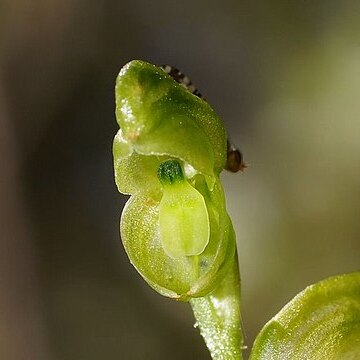Rosette leaves 5–12, ovate to elliptic, 10–45 x 5–18mm, green, fleshy, margins entire or slightly wavy. Flower stem 120–35 tall, 2–22-flowered. Sterile bracts 2–5. Flowers well spaced, translucent green with faint darker green stripes (sometimes almost transparent), 10–14 x 3–4.5mm. Lateral sepals deeply pouched, 6–7 x 7– when flattened. Petals 7–9.5 x 3.5–4.5mm, translucent green with darker veins, margins with beaded siliceous cells. Labellum oblong to elliptic, 2.5–3 x 2.5–3mm, whitish-green with darker green recurved appendage c.2.2 x 1.3mm, with thickened margins and short blunt central ridge.
An orchid. It is a small herb. It keeps growing from year to year. It forms tubers. It grows 10-20 cm high. It has one stem. The leaves are in a ring at the base. There are 5-14 leaves. The flowers are green. There are 2-20 small flowers crowded in a spike arranged like a spiral. Each flower is about 1 cm long. The flowers have a hood.


